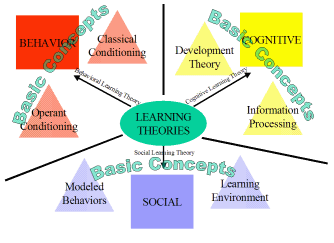
Behavioral Learning Theory - Web Quest

- Behavioral Theory
- Introduction
- Task
- Process
- Resources
- Evaluation
- Conclusion
- Cognitive Theory
- Social Learning Theory
Process
History of theorists and their contributions
- Ivan Pavlov
- Russian Physiologist
- Born, September 14, 1849
- Research throughout 1890's and early 1900's included the physiology of conditioning reflexes
- Won the Nobel Prize in Physiology or Medicine in 1904
- Died, February 27, 1936
- His ideas played a large role in the behaviorist theory of psychology, introduced by John Watson around 1913.
- Edward Thorndike
- American Psychologist
- Born, August 31, 1874
- Learning theory applied to animals and human beings relating to success, pleasure, and satisfaction.
- Law of effect: Responses to a situation that are followed by satisfaction are strengthened; responses that are followed by discomfort are weakened.
- Law of exercise: Stimulus-response connections
- Invented the puzzle box to investigate how animals such as cats and dogs solve problems.
- Died, August 9, 1949
- Paved the way for behaviorists BF Skinner and John Watson
- John B. Watson
- American Psychologist
- Born, January 9, 1878
- He was especially interested in stimulus-response reactions to various situations, such as rats going through a maze.
- "Psychology as the behaviorist views it," Watson wrote, "is a purely objective experimental branch of natural science. Its theoretical goal is the prediction and control of behavior. Introspection forms no essential part of its methods, nor is the scientific value of its data dependent on the readiness with which they lend themselves to interpretation in terms of consciousness."
- Law of frequency: The more frequently a stimulus and response occur in association with each other, the stronger that S-R habit will become.
- Law of recency: The response that has most recently occurred after a particular stimulus is the response most likely to be associated with that stimulus.
- Died, 1958
- Watson was inspired by the work of Ivan Pavlov.
- Edwin R. Guthrie
- Born, January 9, 1886
- Law of contiguity: A stimulus that is followed by a particular response will, upon its recurrence, tend to be followed by the same response again. This S-R connection gains its full strength on one trial.
- Guthrie had the notion of one-trial learning - that an S-R connection is fully formed on one pairing.
- Died, April 23, 1959
- Clark L. Hull
- American Psychologist
- Born, 1884
- Proposed that a number of intervening variables must be considered in order to predict the likelihood and strength of a response's occurrence.
- Died, 1952
- Burrhus Frederic Skinner
- American Psychologist
- Born, March 20, 1904
- Introduced the theory of operant conditioning: a behavior followed by a reinforcing stimulus results in an increased probability of that behavior occurring in the future.
- Died, August 18, 1990
- Followed in the footsteps of Pavlov and Watson.
Critical components /principles
Classical Conditioning Model
Classical conditioning is most likely to occur when the conditioned stimulus is presented just before the unconditioned stimulus; a form of signal learning. In human learning, classical conditioning helps us to understand how individuals learn a variety of involuntary responses. We are conditioned to sleep when it is dark or to eat at certain times of day.Pavlov's work introduced the "classical" concept of stimulus and response: Neutral Stimulus (NS) => No Response (NR) NS + Unconditioned Stimulus (UCS) => Unconditioned Response (UCR) Conditioned Stimulus (CS) => Conditioned Response (CR)
Operant Conditioning Model
A response followed by a reinforcer is strengthened and is therefore more likely to occur again. A reinforcer is a stimulus that increases the frequency of a response it follows. The act of following a response with a reinforcer is called reinforcement.Basic Concepts
Classical Conditioning Model
Extinction: the disappearance of a conditioned response when a conditioned stimulus is repeatedly presented without the unconditioned stimulus. Spontaneous Recovery: the reappearance of a conditioned response after extinction has occurred. Stimulus Generalization: when individuals respond to other stimuli in the same way that they respond to conditioned stimuli. Stimulus Discrimination: the ability to differentiate between to similar stimulus and respond accordingly. Higher-Order Conditioning: where a conditioned stimulus is paired with another neutral stimulus, which then takes on the same response. Sensory Preconditioning: where a response occurs to a stimulus due to an unrelated association to another stimulusOperant Conditioning Model
Free Operant Level (Baseline): the frequency of an operant in the absence of reinforcement. Terminal Behavior: the form and frequency of a desired response at the end of a planned reinforcement program. Extinction: when a response in no longer followed by a reinforcer, and it eventually returns to its baseline rate. Superstitious Behavior: the behavior that occurs in response to randomly reinforced behavior. Shaping: the teaching of a behavior when the free operant level for that behavior is very low or when the desired terminal behavior is different in form from any responses that the organism exhibits. Chaining: the process of teaching a chain of responses by first reinforcing just one response, then reinforcing two responses in a row, then reinforcing a sequence of three, etc.
